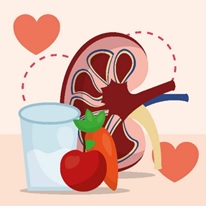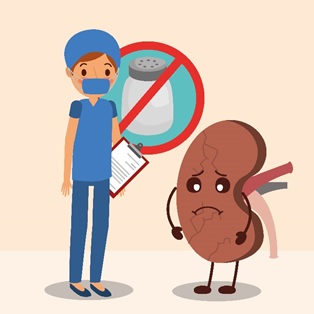
What you eat and drink affects your health. Staying at a healthy weight and eating a balanced diet that is low in salt and fat can help you control your�blood pressure. If you have diabetes, you can help control your blood sugar by carefully choosing what you eat and drink. Controlling high blood pressure and�diabetes�may help prevent kidney disease from getting worse.
�
A kidney-friendly diet may also help protect your kidneys from further damage. A kidney-friendly diet limits certain foods to prevent the minerals in those foods from building up in your body.
�
Basics of a healthy diet
With all diets, including the kidney diet plan, you need to track how much of certain nutrients you take in, such as:
�
Calories:� Your body gets energy from the calories you eat and drink. Calories come from the protein, carbohydrates, and fat in your diet. How many calories you need depends on your age, gender, body size and activity level. Your doctor or dietitian can help you figure out how many calories you should have each day.
�
Protein: Protein is one of the building blocks of your body. Your body needs protein to grow, heal and stay healthy. The amount of protein you should have depends on your body size, activity level and health concerns. Some doctors recommend that people with kidney disease limit protein or change their source of protein. This is because a diet very high in protein can make the kidneys work harder and may cause more damage.
�
Examples of lower-protein foods:
�
Examples of higher-protein foods:
�
Carbohydrates: Carbs are the easiest kind of energy for your body to use. Healthy sources of carbohydrates include fruits and vegetables. Unhealthy sources of carbohydrates include sugar, honey, hard candies, soft drinks, and other sugary drinks.
�
Some carbohydrates are high in potassium and phosphorus, which you may need to limit depending on your stage of kidney disease. You may also need to watch your carbohydrates carefully if you have diabetes.
�
Fat
You need some fat in your diet to stay healthy. Fat gives you energy and helps you use some of the vitamins in your food. But too much fat can lead to weight gain and heart disease. Try to limit fat in your diet and choose healthier fats when you can.
�
Healthier fat or �good� fat is called unsaturated fat. Examples of unsaturated fat include:
�
Saturated fat, also known as �bad� fat, can raise your cholesterol level and raise your risk for heart disease. Examples of saturated fats include:
�
You should also avoid Trans-fat. This kind of fat makes your "bad" cholesterol higher and your "good" cholesterol lower. When this happens, you are more likely to get heart disease, which can cause kidney damage.
�
Trans fat�� primary sources include:
�

�
Avoid Salt (Sodium)
Sodium is a mineral found in almost all foods. Too much sodium can make you thirsty, which can lead to swelling and raise your blood pressure. This can damage your kidneys more and make your heart work harder.
�
High Salt food items are salad dressings, poultry, canned food, packaged food, packaged snacks, chips, frozen meat, salted nuts, pizzas and burritos, sausages, Soy sauce, pickles, vinegar, packaged soups etc.
�
To lower the sodium in daily diet following things to be done-
�

�
How is a kidney-friendly diet different?
How strict your diet should be depending on your stage of kidney disease. In the early stages of kidney disease, you may have little or no limits on what you eat and drink. As your kidney disease gets worse, your doctor may recommend that you limit:
�
Examples of low potassium foods:
�
Examples of low phosphorous foods:
�
Fluids
You need water to live, but when you have kidney disease, you may not need as much. This is because damaged kidneys do not get rid of extra fluid as well as they should. Too much fluid in your body can be dangerous. It can cause high blood pressure, swelling and heart failure. Extra fluid can also build up around your lungs and make it hard to breathe.
�
Depending on your stage of kidney disease and your treatment, your doctor may tell you to limit fluid. If your doctor tells you this, you will need to cut back on how much you drink. You may also need to cut back on some foods that contain a lot of water. Soups or foods that melt, like ice, ice cream and gelatin, have a lot of water. Many fruits and vegetables are high in water, too.
�